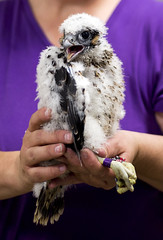
Crossposted from Beta|Erinyes.
Whirl has never seen the Mississippi River. This seems like a horrible oversight when you consider the following facts: the Mississippi River forms the western boundary of Illinois for 550 miles; Whirl has lived in Illinois for nearly 18 years. I mean, it’s right there. It’s a huge river. It’s worth going to take a look at for just that reason alone. But, for whatever reason, she’s never travelled anywhere along its length. So when the assignment desk handed out the banding task for the two chicks nesting on top of a grain elevator in Savanna, she jumped at the chance. And then immediately turned around and asked if I wanted to come along and shoot.
So I took a day off from work and we got up early in the morning to catch the train up to Wilmette where we met up with Matt. After a quick stop to get coffee, we were off on a three-hour road trip across the state to Savanna. We travelled for a while through construction season along I-90 before heading off on US highways and quiet, rolling state roads. It reminded me that you don’t need to go particularly far to get completely out of the big city of Chicago. I tend to forget that from time to time, and it’s nice to be reminded every once in a while.
We gathered two more members of the day’s team from the local US Fish and Wildlife office. Eric and his intern, Jamela, joined us and we headed over to the Consolidated Grain and Barge elevator that sits directly on the Mississippi riverbank in Savanna.
As we waited for Jeff from CGB to arrive and provide access, Whirl took in the expanse of the river. The Mississippi is running five feet above normal and has flooded all of the river islands. In April it was running even higher and flooded into the town. Although we learned that the extent of the damage was mostly limited to a few business basements and that the business owners had sworn off FEMA assistance and resolved the damage themselves.
 Jeff arrived and the team got to work. I was on the camera. CGB and US Fish and Wildlife installed a nest box on the elevator in February, 2010. A camera was added in February, 2012. Both of the peregrine adults are unbanded– a fact that has been proved many times by the nest cam– so my photo assignment was just to take some fun pictures and document the area.
Jeff arrived and the team got to work. I was on the camera. CGB and US Fish and Wildlife installed a nest box on the elevator in February, 2010. A camera was added in February, 2012. Both of the peregrine adults are unbanded– a fact that has been proved many times by the nest cam– so my photo assignment was just to take some fun pictures and document the area.
Meanwhile:
- Hard hats? Check!
- Heavy jackets? Check!
- Climbing ropes and harnesses? Check!
- High-tech cardboard box for chick transport? Check!
So while Eric, Jamela and Matt headed up to the roof of the grain elevator, I stood on the riverbank with Whirl and tracked the two adults as they harried the well-intentioned chick-nappers.
 Peregrines are noisy. When they are defending a nest, they are very vocal. They attract attention. Shortly after the trio went up to the roof and stirred them up, we were greeted by about a half dozen neighbors living nearby curious to see what was going on. Everyone we met was very friendly and happy to share their experiences with the birds. The town has really embraced them living there. I like to see that.
Peregrines are noisy. When they are defending a nest, they are very vocal. They attract attention. Shortly after the trio went up to the roof and stirred them up, we were greeted by about a half dozen neighbors living nearby curious to see what was going on. Everyone we met was very friendly and happy to share their experiences with the birds. The town has really embraced them living there. I like to see that.
It was a cool and cloudy spring day. Matt and Whirl set up the banding table outside under a big shade tree. The banding went quite well. One female, one male. Although I do need to mention that when Matt brought out the needles to draw blood, the small crowd that had gathered around to watch quickly dispersed. I took a few pictures of the process and got a portrait of each chick before returning to try and get a picture of a killdeer in flight– a task that proved too difficult. I settled for a Great Blue Heron in flight. Bigger, slower target. Easier to get. Still a magnificent bird.

Matt and Eric returned the chicks to the nest box. The adults calmed down and we headed off to get some lunch. At lunch we met up with Matt’s college roommate, Al, who also works for US Fish and Wildlife in land reclamation. Al took us to Hawg Dawgs, a biker bar with delicious burgers attached to Frank Fritz Finds of American Pickers fame. Over lunch– and for some time after lunch– Al spun story after story about his work, the town, the river, himself, college with Matt and just about anything else you could ask for. Al was great company. After lunch he took us up to Mississippi Palisades State Park north of Savanna. We climbed up onto the river bluff and took in the expanse while dodging huge swarms of flies and mosquitos.
After a quick stop at the flooded boat launch and the gas station to refuel for the trip back, we headed off for home.
It was a very good day.
Posted in IL Savanna
















